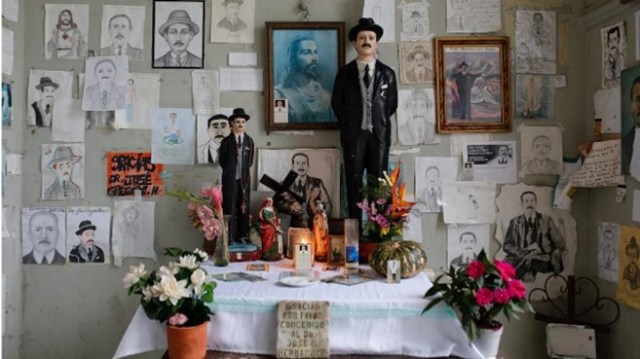
Venezuelans celebrate a milestone in its quest for sainthood for José Gregorio Hernández, the country’s beloved “doctor of the poor.”
By National Geographic – Amy McKeever
May 3, 2021
The slim mustachioed man’s presence hung over Caracas last week – in makeshift shrines at local hospitals, on murals painted on city walls, and within the crowd of Venezuelans of all ages cheering, crying, applauding after a ceremony unfolded that put the beloved “doctor of the poor” on a solid path to sainthood – triggering optimism among the faithful.
“People believe that he will bring peace to the country,” says Manaure Quintero, who photographed these scenes for National Geographic.
The beatification of José Gregorio Hernández marks the penultimate step on the road to sainthood in the Catholic Church. Since his death in 1919, Hernández has become an iconic figure in the overwhelmingly Catholic country, where devotees pray to him for healing. (Why Venezuelans are turning to faith as the country’s health crisis deepens.)
Hernández is now the first Venezuelan layman to be beatified – a milestone that comes 72 years after his sainthood petition was first launched. It’s a rare ray of light for the country, which has been in the midst of a political and economic crisis for years and has been hard-hit by the coronavirus pandemic.
Now, for Hernández to become a saint, it’ll take a miracle – literally: The Church requires proof of one before it elevates someone to sainthood. Here’s a look at the sainthood case for Venezuela’s beloved doctor of the poor and how the Church decides if a miracle is a miracle.
A beloved doctor and scientist
José Gregorio Hernández was born on October 26, 1864, in a small town about 269 miles west of Caracas called Isnotú. Raised Catholic, Hernández considered becoming a priest but instead pursued a medical career. He received scholarships to study experimental physiology and bacteriology in Europe, then brought his knowledge back to a modernizing Venezuela.
Hernández founded three medical science departments at the Central University of Venezuela in Caracas and is credited with introducing Venezuela to the microscope. But in addition to his work as a scientist, Hernández also practiced medicine and became known for treating the needy for free.
The doctor’s memory lived on—not just in Venezuela but in its diaspora and throughout other parts of Latin America. His tomb became a pilgrimage site and soon began to spawn folk stories about miracle healings. In 1949, 30 years after his death, the archbishop of Caracas initiated a petition to declare Hernández a saint.
Quintero says that his countrymen’s belief in Hernández has only grown in the years since. Venezuelans pray to the doctor to bring an end to their suffering and claim to see him walking the corridors of local hospitals in his iconic black suit.
“If you live in a place where you don’t trust in hospitals, the other option for relief is faith,” Quintero says. “They feel safe with him.”
The sainthood process
In the Catholic Church, sainthood is an official confirmation that a person has entered God’s eternal presence – basically, that they made it to heaven. Saints are no different from anyone else in heaven, but the title changes how they’re venerated on Earth: The Church can erect shrines to them or designate days in their honor, for example.
The definition of what is holy changes over time, says Kathleen Sprows Cummings, history professor at the University of Notre Dame and author of the book A Saint of Our Own. “We reinvent saints in each age.”
But the long and complicated process for becoming a saint—called canonization – has been roughly the same since the 17th century. It begins at the local level: Anyone can open a petition, but they must convince their bishop that the case for sainthood, called a cause, is worthy. A candidate for sainthood also has to have been dead for at least five years, although the Pope can make exceptions. (Here’s how Mother Teresa’s canonization was fast-tracked.)
That’s when the miracles come in. The Catholic Church requires evidence of one miracle to beatify a prospective saint and then a second to officially canonize them. This can’t be just any miracle either: It involves devotees praying to the prospective saint and asking them to use their pull with God to convince him to carry out the miracle.
“Miracles are a sign that God wants the person canonized,” Cummings says.
…
Read More: National Geographic – In Venezuela, a quest for sainthood offers proof of miracles
…

